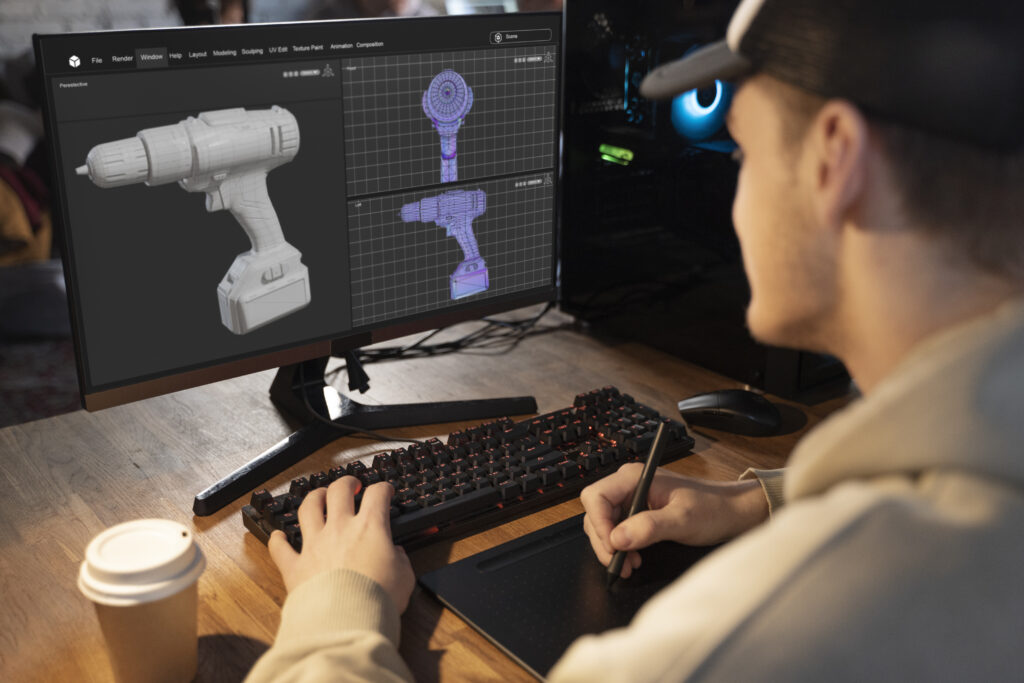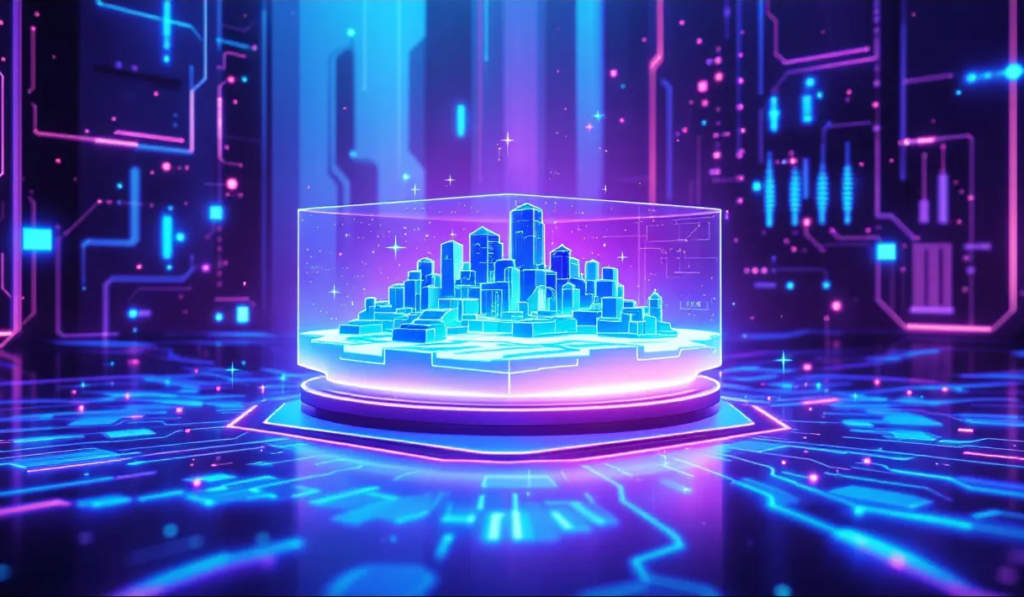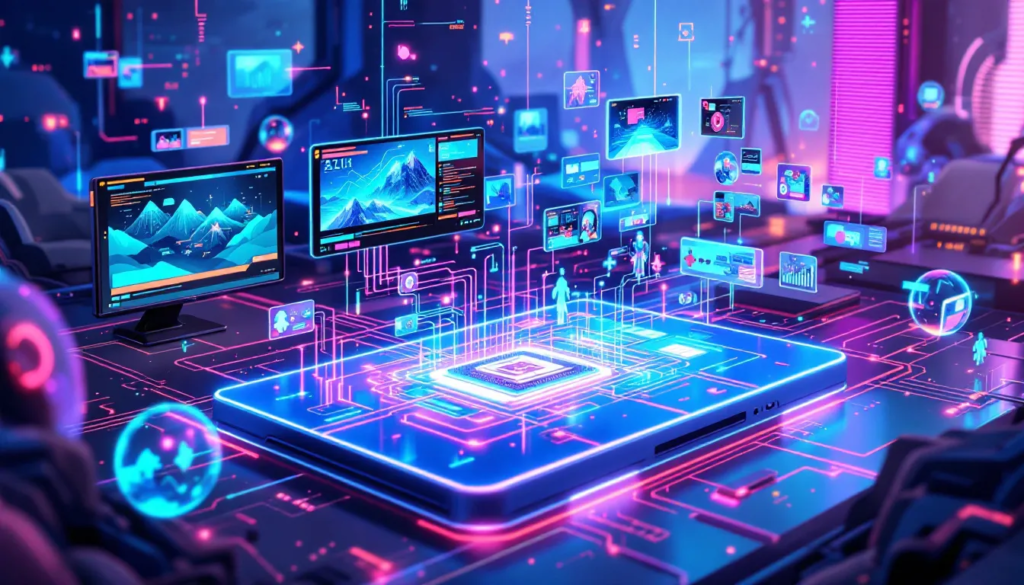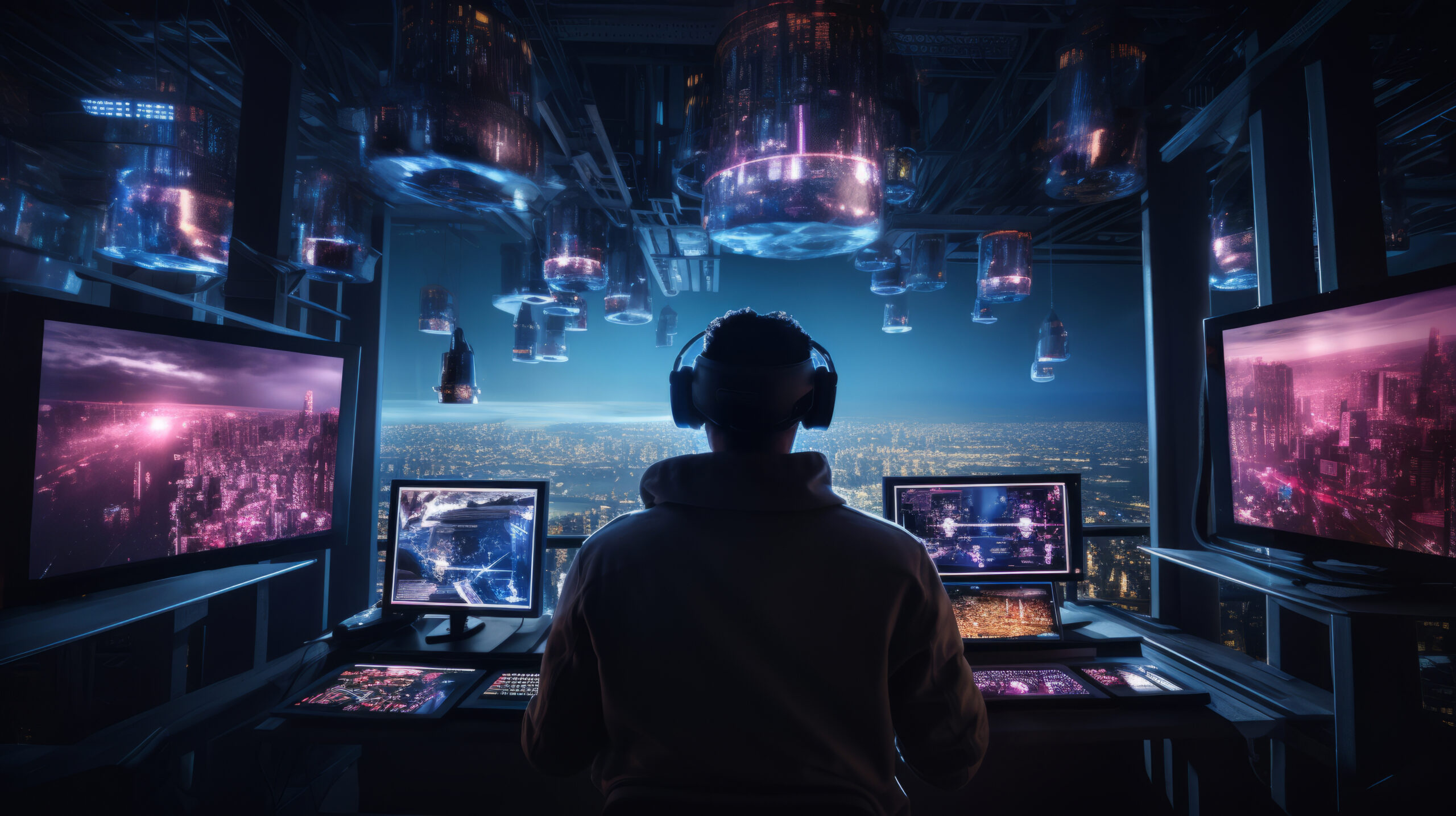AI is revolutionizing video game development by automating tasks, enhancing graphics, and creating immersive experiences. From story creation to character development, AI in video game development is changing how games are made. This article explores AI’s impact on game development and the innovations shaping its future.
Key Takeaways
– AI is fundamentally transforming video game development through automation, enhancing creative processes and player experiences.
– Generative AI tools are revolutionizing game design by efficiently creating diverse assets and procedural content, improving both efficiency and creativity.
– AI-driven storytelling and NPC behavior enhance immersion and personalization, allowing for dynamic game worlds that adapt to player choices.
AI in Video Game Development: An Overview
AI plays a crucial role in the development of video games. It affects various aspects, including character behavior and game design. At the heart of this transformation are AI algorithms that enhance various aspects of gaming, from gameplay mechanics and graphics to the overall player experience. Automating labor-intensive tasks allows developers to concentrate on creativity, resulting in more realistic and personalized games. This automation enhances game playability and ensures that elements adapt to individual player interactions, creating a richer, more immersive experience in ai game development.
One of the most significant impacts of AI in video game development is its ability to create complex worlds and characters. AI can generate deeper graphics and more intricate player experiences, pushing the boundaries of what is possible in gaming. AI is transforming every aspect of game development, including:
– Story creation
– World-building
– Character development
– Asset creation
This ongoing evolution of AI technologies continues to redefine the creative and technical processes involved in video games, making them more dynamic and engaging.
As the gaming industry continues to embrace AI, we are witnessing unprecedented levels of innovation and creativity. AI in video games is not just about enhancing visuals or automating tasks; it’s about creating a new era of gaming where player experiences are richer, more dynamic, and deeply personalized. With AI at the helm, the future of video game development is set to be more exciting and transformative than ever before.
Generative AI Tools for Game Design

Generative AI tools are revolutionizing game design by enabling the creation of various game assets such as text, images, audio, and video clips. These tools bypass human limitations, allowing for the indefinite creation of assets and significantly enhancing the efficiency and creativity of the game development process. AI tools transform game design by automating procedural content generation, efficiently creating levels, maps, and characters.
Adobe Firefly exemplifies current AI capabilities in creating compelling game assets, a notable example of how these tools not only streamline the creative process but also enable game developers to focus on more complex and creative aspects of game design.
The impact of generative AI on video game development is profound, as it continues to transform the way games are designed and developed.
Concept Art Creation
The creation of concept art is a critical step in the video game development process, and generative AI tools have made it more efficient and innovative. These tools enable the quick generation and iteration of ideas, producing unique and high-quality concept art that serves as the foundation for game worlds. Artbreeder, for instance, helps game developers create characters, assets, and environments by allowing image blending, making it easier to visualize and refine concepts.
However, the integration of AI in creating game assets has raised some concerns regarding technical limitations. There is a potential risk of job displacement for artists who traditionally produce these assets.
Despite these concerns, the benefits of AI in concept art creation are undeniable, as it accelerates the creative process and enables the production of diverse and innovative game content.
Automated 3D Modeling
AI has also made significant strides in automated 3D modeling, a crucial aspect of game development. NVIDIA’s GANverse3D, for example, uses AI to create realistic 3D object models from 2D images, drastically reducing the time and effort required to produce detailed 3D assets.
This capability enables game developers to create more complex and visually stunning virtual environments in virtual worlds, enhancing the overall gaming experience.
Dynamic Game Elements
One of the most exciting applications of game development ai in game development is the generation of dynamic game elements. AI can generate:
real-time dialogues
terrain
soundscapes
music that adapt to player actions, significantly enhancing immersion and replayability.
For example, the game Oasis, which simulates Minecraft, uses AI to predict gameplay frames and adapt the experience to players. This dynamic generation ensures that each playthrough offers a unique experience, keeping players engaged and entertained.
Generative adversarial networks (GANs) are particularly noteworthy in this context. They create new game content by learning from existing levels, autonomously designing new playable levels. Researchers at the University of California have used GANs to generate levels for Super Mario, while others have created new playable levels for Doom. These advancements demonstrate AI’s ability to innovate and expand the possibilities of game design.
Game developers and game designers are also experimenting with AI to enhance narrative depth and player engagement. Ubisoft, for instance, is using AI to generate basic dialogue, contributing to more immersive storytelling. Integrating AI allows designers to develop interactive and engaging worlds that dynamically respond to player behavior.
Enhancing NPC Behavior with AI
Non-player characters (NPCs) play a crucial role in creating immersive game environments, and AI has revolutionized their behavior. Generative AI enables NPCs to perform complex tasks and exhibit behaviors that respond dynamically to player actions. This has led to more engaging and lifelike interactions, enhancing the overall player experience. For instance, the Nemesis System in ‘Middle-earth: Shadow of Mordor’ generates NPC storylines influenced by player actions, creating a more immersive and personalized experience.
AI-driven character animations have also made significant strides, leading to smoother transitions and more lifelike movements in games. AI algorithms interpret complex motion data to enable lifelike interactions and realistic responses to environmental stimuli. These advancements in AI technologies have significantly improved the realism of NPCs, making interactions with them more realistic and engaging.
Realistic Animations
AI’s ability to utilize motion capture data has transformed NPC animations, making movements smoother and more fluid. Realistic animations are crucial for enhancing the visual fidelity of video games, contributing significantly to the overall player experience.
Advanced Interpreting complex motion data, AI algorithms enable lifelike interactions and realistic responses to environmental stimuli. The result is more engaging and believable NPC behavior, drawing players further into the game’s narrative and world.
Adaptive Interactions
Adaptive behavior models in NPC AI allow them to analyze and learn from players’ decisions in real-time, leading to more responsive and personalized interactions. AI driven npcs can change their dialogue and actions based on previous player interactions, creating a more personalized experience through natural language processing.
Combat AI, for example, enables NPCs to adjust their tactics based on the player’s actions, leading to more challenging and engaging gameplay. These adaptive interactions make NPCs feel more alive and integral to the game world, enhancing immersion and player engagement.
Procedural Content Generation in Games
Procedural content generation (PCG) is a technique that creates game content automatically, allowing for adaptive content that responds to player actions. AI-driven procedural generation provides significant benefits, including time savings and reduction of costs on artists, creating coherent and immersive settings that adapt to player choices. This dynamic application of AI ensures consistency in the game world, making it more engaging and immersive for players.
PCG has become an essential tool in modern game development, enabling the creation of vast, detailed game worlds without the need for extensive manual design. AI-generated content can introduce unexpected elements that enrich the gameplay experience, enhancing immersion and replayability, much like the innovations seen in grand theft auto.
Creating Immersive Worlds
AI plays a crucial role in creating diverse and immersive game worlds. Generative algorithms can create varied environments without manual design, optimizing player engagement. Tools like NVIDIA’s GANverse3D and Autodesk’s generative design tools assist in creating 3D models, automating the creation of complex models and textures.
Companies are using AI to create artwork for scenes, enhancing visuals and environments, and adding lifelike elements to in-game scenes. This enhances the realism and immersion of game worlds, drawing players deeper into the game environment.
Enhancing Replayability
AI-generated variations allow for unique experiences in each playthrough, making games feel fresh and engaging. Introducing procedural elements driven by AI can significantly boost a game’s replay value by offering new challenges and game mechanics.
AI plays a pivotal ai’s role in generating diverse content that enhances the replay value of video games, ensuring that players remain engaged and entertained over extended periods. By continuously providing players with new content and experiences, AI continues to enhance the replayability of games, making them more enjoyable and long-lasting.
AI in Game Testing and Quality Assurance

AI is transforming game testing and quality assurance by automating these processes, which is expected to grow in the gaming industry. AI contributes to game testing by automating the identification of glitches and bugs, while optimizing game performance.
With AI, millions of gameplay scenarios can be simulated to stress-test games beyond human capability, leading to improved identification of issues and ultimately benefiting the overall development process. Automated testing significantly increases efficiency in the game development process and minimizes potential errors, allowing developers to simulate millions of scenarios effectively.
Automated Bug Detection
Commit Assistant and similar AI tools predict potential bugs by analyzing historical coding errors through data analysis. By examining past interactions, AI tools help developers identify where new bugs might arise, significantly improving the efficiency of identifying bugs, fine-tuning games, and automating repetitive tasks, including code review.
This enhances the overall quality of the game and ensures a smoother player experience.
Optimizing Game Performance
AI improves game performance by suggesting resource management strategies based on real-time performance data. Game ai aids in optimizing game performance by analyzing data and suggesting improvements, ensuring smooth and efficient gameplay.
This leads to a better player experience and higher-quality games.
AI-Driven Storytelling
AI-driven storytelling is transforming the narrative aspect of video games, creating unique and personalized gaming experiences. Key features include:
– Tools like AI Dungeon use machine learning to create evolving stories that reflect player choices.
– Offering branching storylines that adapt based on player decisions.
– Allowing real-time narrative evolution by responding to player actions and choices.
– Making players feel responsible for the narrative.
– Creating unique experiences for players, enhancing engagement and immersion.
AI can analyze player behavior to refine and enhance storytelling elements, better engaging players and creating a more immersive experience. In future games, AI technology may enable characters to have evolving personalities based on player interactions, further personalizing the gaming experience.
This level of personalization and adaptive storytelling is set to redefine the narrative aspect of video games.
AI in Game Graphics and Visual Effects
AI significantly enhances game graphics by:
– Enabling realistic visuals
– Generating textures
– Enhancing lighting
– Upscaling resolutions
Texture generation automation through AI enhances the realism of textures used in games, making environments and characters more lifelike.
AI also enhances lighting in games by automatically adjusting light sources for more natural and dynamic effects. Simulating complex environments, the ai model enhances visual effects, contributing to more immersive and visually stunning games. This is where an ai tool can play a significant role, as ai determines how these adjustments are made. Additionally, ai models can further improve these processes.
Ethical Considerations and Challenges
While AI brings numerous advancements to video game development, it also raises significant ethical considerations and challenges. AI technologies could potentially replace millions of jobs across various sectors, creating significant ethical dilemmas and social disruption, particularly in communities reliant on industries facing automation. Job loss due to AI can significantly impact mental health, leading to anxiety and depression among displaced workers.
Companies that implement AI technologies are ethically responsible for considering the potential impacts on employment and local communities. Equitable access to retraining programs is crucial for helping displaced workers transition to new job opportunities.
Additionally, concerns about data privacy and player manipulation have emerged as challenges with the implementation of AI in games. Legal frameworks are necessary to regulate AI’s ethical use, addressing concerns like data privacy and accountability.
The Future of AI in Video Game Development

The future of AI in video game development holds immense potential, focusing on creating hyper-realistic assets, enabling rapid environment creation, and reacting to player demands. Anticipated advancements in AI technology include more immersive games where characters learn and adapt, with evolving environments and personalized narratives. AI will facilitate faster and more efficient content creation in games, transforming how developers approach game design. The future of gaming will enhance personalization, providing unique experiences for each player with tailored levels and stories.
Augmented reality gaming is projected to apply AI in ways that transform real-world elements into engaging game content. Players can expect games that offer unique interactive experiences in AI-enhanced virtual reality and augmented reality environments, fostering connection and immersion.
Key areas of advancement include ai for NPC behavior, where AI-powered systems create more realistic enemy AI systems that respond dynamically to player actions. Procedural content generation AI will continue to evolve, enabling vast and varied game worlds that adapt to player choices. Machine learning in game design will allow developers to optimize game difficulty balancing with AI, ensuring each player faces appropriate challenges. Neural networks in game development will enhance ai storytelling in games, crafting narratives that evolve based on player decisions.
Additionally, AI in player behavior prediction will enable adaptive gameplay using AI, creating personalized experiences that respond in real-time. AI-powered game testing will streamline quality assurance processes, allowing developers to identify bugs and optimize performance efficiently.
With AI’s continuous evolution, the possibilities for richer, more dynamic, and personalized gaming experiences are virtually limitless.
Summary
In summary, AI has revolutionized video game development, enhancing everything from concept art creation to NPC behavior and procedural content generation. AI tools enable game developers to automate labor-intensive tasks, create dynamic game elements, and optimize game performance. These advancements have led to more immersive and personalized player experiences, pushing the boundaries of what is possible in gaming.
As we look to the future, AI will continue to shape the gaming industry, offering new opportunities for innovation and creativity. The potential for AI-driven storytelling, realistic graphics, and adaptive game environments is immense, promising a future where games are more engaging and personalized than ever before. The journey of AI in video game development is just beginning, and the possibilities are endless.

Leave a Reply